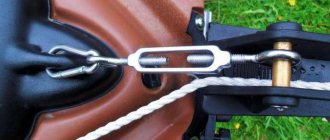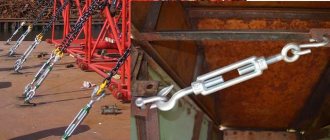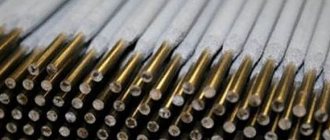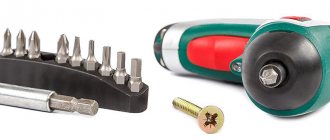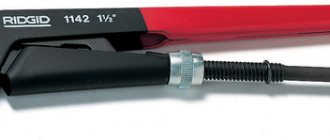A lanyard is a rigging device that allows you to attach ropes, cables, chains, ropes to supports and easily adjust the tension of guy wires when they weaken or sag during operation. These simple screw devices were initially used on ships, but gradually began to be used in other areas of human activity, for example, when installing or strengthening structures, securing transported cargo, when it is necessary to create a large tension force.
Today, cable tensioners are successfully used in various engineering structures; they help prevent emergency situations during cargo transportation, provide tension on cable fences, cable networks between houses, and hold antennas, masts, lightning rods, and bridges. In this case, the fixation of the cable can be temporary (for example, securing loads or installing tents) or permanent (for example, installing curtain strings or strengthening engineering structures).
The intended purpose of the device is determined by its design, standard size and strength characteristics. The most common standard mounting lanyard is a screw tie, depending on the size of which you can create a tension force from several kilograms to tens of tons. For high loads, only DIN 1478 (fork-fork) lanyard is used.
Operating principle and types of screw lanyards
A screw cable tensioner consists of a coupling-housing with two threaded holes for screws with different thread directions. When the couplings are rotated in one direction, they are screwed into the body, and in the other they are unscrewed, which allows you to continuously change the overall length of the tightening device. Adjustment does not require special physical effort and can be done at any time as needed.
The turnbuckle body has two versions - open or closed (bushing). The latter are suitable for harsh operating conditions, when there is a risk of damage, icing, clogging of the tension mechanism with dirt or sand. According to the manufacturing method, couplings are welded, stamped, forged and cast.
Screw heads are made in the form of a hook, a ring, a fork, a pin, or a combination of these, such as a hook-ring or a fork-eye. A high level of reliability is ensured by fork-fork tensioners. A welded stud-stud lanyard is used in cases where it is necessary to connect it with other rigging elements or structures by welding, thereby creating a permanent connection.
GOST 9690-71
According to GOST 9690-71, there are the following types of lanyards:
- OS - with open coupling;
- OZ - with a closed coupling;
- ОШ - with a stamped coupling.
Types of lanyards:
- VU - fork-eye;
- BB - fork-fork;
- UU - ear-ear.
Lanyards manufactured in accordance with GOST 9690-71 are used on ships and other floating craft. OSH parts are made of carbon steel, in the following versions:
- VU - fork-eye;
- BB - fork-fork;
- УУ - ear-ear;
- VG - hook fork;
- GG - gak-kak;
- GU - gak-ear.
Lanyard OS are made of magnetic and carbon steels and come in the following versions:
- BB - fork-fork;
- УУ - ear-ear;
- VU - fork-eye.
ZS lanyard is made of steel with a high carbon content and in two types:
- BB - fork-fork;
- VG - fork-hook.
To protect against friction, graphite lubricant is applied to the surface of the rubbing elements. According to GOST, nuts are used to fix the position of the ears (forks). The main purpose of the part is to enhance linear tension. Do not use for lifting loads. When engaging the turnbuckle, there should be no loose turns on the coupling.
Standards, loads and sizes of lanyards
In the post-Soviet space, their production is regulated by GOST 9690, in Europe they adhere to the standards DIN 1480 and DIN 1478, in the USA ASTM F1145-05 applies.
Lanyard DIN 1480 is a general-purpose device not intended for work that involves lifting loads. It withstands high static loads, perfectly holds tension ropes and ensures reliable fixation of vertical structures. Its load capacity ranges from a few kilograms to 3 tons. In everyday life it is used, for example, for stretching clotheslines or strings for curtains.
Lanyard DIN 1478 is a cargo lanyard with fork hooks, made of high-strength steel, has a safety factor of at least 4:1 and is designed for higher static and dynamic loads (up to 10 tons). Approved for use in systems with high tension, for example, when securing multi-ton cargo on transport, in the construction of suspension bridges, for organizing guy wires for awnings, tents, and massive antenna mast systems.
The size of the screw tie is determined by the diameter of the thread, which has standard metric characteristics and a diameter from M5 to M56. The most popular models: hook-ring lanyard M8, M10, M12, M16 or ring-ring M8, M10, M12. Another important parameter of the product is its length when fully untwisted (L1) and in the screwed state (L), the difference between them (L1-L) is a linear value within which the tension of the rope branch can be adjusted.
How to do it yourself
The type of fastener in question is easy to manufacture. To make it yourself, no special skills are required.
Materials:
- Bolt
- screw
- Rope
Tools:
- Bulgarian
- Vise
- Wrench
- File
After preparing all the necessary tools, start making. First of all, you need to know that during the creation of the cable fastening, the bolt thread will be damaged and cut off. To re-cut the ground surface, use a grinder or a sharpening machine. The grinder can be replaced with a simple hacksaw.
After restoring the thread, a cut is made along the bolt. A small rope is placed in the cut (it must be the right size). Then it is secured with a nut. How to use a cable clamp? They are usually needed to secure loops at the ends of ropes. This type is useful in everyday life, for example, for hanging various vessels and buckets.
Of course, this DIY device cannot be used for “more serious purposes.” That is, it will not be able to withstand a sufficient load in the form of any object that is suspended on a cable. Naturally, the rope is quite strong and, therefore, there is no point in using it to hang buckets.
There are many types of clamps. The article does not cover all of them, but only some of them.
Galvanized or stainless steel lanyard?
When choosing a screw tie, you should take into account the external conditions in which it will work and the degree of aggressiveness of this environment. For dry rooms and temporary outdoor use, it is enough to purchase a galvanized cable tensioner. For constant use outdoors, in places with a humid and frosty climate, closed stainless steel lanyards made of A2 steel are suitable, and in particularly aggressive conditions (chemical production, maritime shipping, hot shops, pools with chlorinated water) - made of acid-resistant steel A4.
Did you know?
If you need to cut a thread in a hole and don’t have a tap holder at hand, a regular screw lanyard will help out. Clamp the shank of the tap between its screws, and use the body of the device as a driver.
Cable-stayed fastenings (chain tensioners)
Hook-hook chain lanyard (ratchet) is the name of a cable-stayed fastening with hook grips, designed for securing large and heavy loads with chains on transport platforms. The devices have a ratchet or lever mechanism, through which a large tension force is easily created.
The chain tie-down is a simple and reliable manual mechanism used all over the world in securing systems for large-size and heavy-tonnage loads. It is used to tension fastening chains, which in turn securely fix and hold the load, preventing its spontaneous movement or fall during transportation by road, rail and other modes of transport. Based on their design, they come in two types, the characteristics of which are discussed below.
Ratchet type tightening device
This chain lanyard consists of a ratchet mechanism with a rotation switch and two rotary hooks located at opposite ends of the device. The tension of the fastening chains is ensured by the convergence of the hooks by turning the mechanism handle. The positive features of this ratchet include:
- ease of installation of the device into the mounting system;
- application of minimal physical effort when working;
- lever that does not require additional fixation.
Lever type tightening device
Its design also consists of two rotary hooks that ensure the engagement of the chain fastening branch, as well as an eccentric lever mechanism. In this case, the tension of the chains is ensured by applying manual force to the eccentric mechanism, which, passing through the point of maximum tension, self-clamps. Reliable fixation of the lever is ensured by the chain itself, which pushes the device to the sides and thereby prevents the mechanism from opening. The positive features of this chain lanyard include:
- minimal installation time;
- simplicity of design;
- small sizes;
- absence of a protruding lever in the operating position of the device.
Instructions for installing clamps
When using the most popular DIN 741 clamp, it is necessary to insert both ends of the cable into the clamp selected for the size of the cable, and insert the thimble into the resulting loop. The clamp should be secured with nuts so that its steel base is on the side of the load-bearing (long) end. For reliability, 2-3 clamps are usually installed in a row. How to fasten the cable clamps in one unit can be clearly seen in the picture below.
The tightening force of the nuts is selected experimentally. After installation, a load test is carried out. If the clamps do not move or cut the cable, then they are installed correctly. Otherwise, adjustments must be made at the moment of tightening. Similar recommendations apply to flat clamps.
If the clamps are used for a long time, the clamping force should be checked periodically. It may change over time due to changes in temperature and humidity.
Installing cable clamps is a critical operation. Compliance with the basic installation rules and full control over the process is the key to the reliability of the entire structure.
Where to buy a lanyard in St. Petersburg?
In our Krepkom store you can buy hook-ring, ring-ring, hook-hook, fork-fork lanyards, as well as chain ratchets for transporting heavy equipment, equipment, and logs. All of them have been load tested and have a large safety margin (4:1, 5:1, 6:1). How much do these rigging devices cost? – The price of a lanyard largely depends on its size. The price range for “Strong” is as follows: from 150 to 7,000 rubles per unit of goods.
We hope this review article will help you make the right decision when choosing a rigging lanyard for tensioning a cable or chain.
Chains, slings, rigging Updated: 07/13/2021 13:55:41
Operating rules
Before starting work, you need to check the strength of the rope clamps. After the first application of load on the cable, the tightening torque must be checked again and adjusted if necessary. It is necessary that products are regularly inspected and tested. This is necessary due to the fact that during operation the products are subject to wear and overload, which will lead to deformations and changes in the structure of the material. Rope end clamps should be inspected at least once every six months, and even more often if the products are used in harsh working conditions.
It is not allowed to bend or adjust the shape of the clamp, as this will deteriorate the quality of the product and reduce its ultimate strength.
The following factors can negatively affect the tightness of the clamps on the cable:
- the nut sits tightly on the thread, but not tightly in relation to the jumper;
- the thread is clogged with dirt, oil, and corrosion products, preventing the necessary tightening of the nut.

